Abstract
This study investigates the influence of driver-related factors on on-street parking choice by integrating stated preference (SP) and revealed preference (RP) survey methods. A hybrid SP–RP survey was designed to simulate realistic parking scenarios, and 423 valid questionnaires were collected online and offline. Key factors affecting parking choice were identified through descriptive analysis, including user acceptance of differentiated pricing and satisfaction with existing policies. The Kaiser–Meyer–Olkin (KMO = 0.904) and Bartlett’s test (p < 0.001) confirmed data suitability for factor analysis. A binary logistic regression model was developed to quantify variable effects under different travel purposes. Key findings include the following: monthly parking fee had the strongest effect (OR = 6.691, p = 0.010) on parking choice for shopping/entertainment trips; model prediction accuracy ranged from 80.87% to 83.56% across travel purposes; and goodness-of-fit metrics were strong (McFadden R2 = 0.630, Nagelkerke R2 = 0.772). The results provide empirical evidence on parking choice determinants and support the design of demand-responsive parking policies through dynamic and differentiated pricing strategies.
1. Introduction
With the continuous progress of the automobile manufacturing industry and the steady growth of the national economy, the number of automobiles in China is also increasing year by year. According to statistics [1], as of the end of June 2025, the total number of motor vehicles in China has exceeded 460 million, of which the total number of cars exceeds 359 million.
With the increasing number of cars and the limited urban space, the supply–demand contradiction of parking spaces is becoming increasingly prominent.
However, in many cities, parking problems are not solely caused by insufficient supply but rather by improper pricing strategies for parking fees [2]. The current parking fee system is mostly based on the economic situation [3] and parking demand of administrative regions [4,5] but ignores the characteristics of parking time and location, lacking scientific theoretical support. This leads to parking fees not fully utilizing their price lever adjustment function and hence being unable to effectively guide the traffic flow of the city. Therefore, it is crucial to study and implement differentiated charging methods based on the characteristics of parking time and space demand. By comprehensively considering the spatio-temporal characteristics of parking, we can more accurately reflect the true value of parking, guide drivers to choose parking locations and times more reasonably, alleviate parking pressure in cities, and promote the healthy development of urban transportation.
On-street parking and cruising behavior is an implicit behavior pattern of drivers in the process of choosing to park. When making parking decisions, drivers will consider many factors, including but not limited to parking fees, convenience of parking location, surrounding traffic conditions, etc. [6,7]. Sometimes, in search of an ideal parking space, drivers may drive slowly on the road at lower speeds, which often creates congestion and creates a mobility bottleneck. Inci [5] investigated the economic influence of pricing on on-street parking and pointed out that reasonable parking pricing can attract more drivers to choose on-street parking and make better use of on-street parking resources. In order to study and understand this behavior in depth, Albert et al. used the stated preference (SP) survey method to conduct extensive research on travel groups to explore the impact of congestion charging and parking charging on residents’ travel choice behavior. His research results show that when faced with a choice, travelers are more inclined to pay parking fees rather than congestion fees [8]. Tian conducted an in-depth study on the impact of randomly distributed parking spaces on drivers’ micro-parking behavior on the roadside. In his study, he considered multiple measures, including vehicle cruising, travel costs, walking costs, and delay costs, to analyze how these factors affect the time a driver chooses to stop and the arrival time [9]. Hensher, David A., and King conducted a survey on eight parking lots in the Sydney CBD area and found that increasing parking fees will encourage travelers to choose to use public transportation and will have a significant impact on the way drivers choose to park [10]. Guo and Zhan used the B-Logit method to model the survey data of 840 households in New York. The results showed that drivers with family parking spaces tend to use cars, while drivers without family parking spaces choose other travel modes [11]. Jackob [2] uses macro modeling methods to study the short-term impact of different parking policies on urban transportation and parking systems, with a particular focus on two major strategies: parking pricing and parking occupancy rate. The paper takes the central area of Zurich, Switzerland as a case study to demonstrate the application of the model and the actual effects of policies. Qian et al. [12] found in their research that differences in lifestyle and the level of environmental awareness will have a significant impact on the choice of travel mode. As residents’ awareness of environmental protection gradually increases, they are more inclined to choose public transportation, and accordingly, the frequency of private car travel will gradually decrease. Hensher [13] and others used discrete choice models to study travel choice behavior. Their studies all found that income level has a significant impact on the choice of travel mode. This study provides an important basis for understanding the differences in travel decisions of different income groups.
When discussing travelers’ parking choice behavior, although scholars made extensive use of parking data and conducted multi-angle, multi-objective research, they failed to fully take into account the time and space needs of travelers when making parking choices as well as the influencing factors behind these needs.
Roadside parking and cruising are one of the main causes of traffic congestion [14]. Relevant research has pointed that when the utilization rate of parking spaces is maintained at 85%, the parking spaces reach a state of supply–demand balance, and the parking fee price at this time is considered relatively reasonable [15]. Fosgerau et al. considered the travel conditions during peak hours in the morning and evening and proposed a strategy of dynamically charging based on parking hours. They applied the queuing theory to calculate the optimal charging rate and suggested eliminating queuing time by distinguishing different time periods. Specifically, in the first time period (when parking demand is low), the parking fee is zero to reduce queuing phenomena; in the second period (when there is a high demand for parking), parking fees are charged to alleviate the problem of parking congestion [16]. Qin et al. [17] conducted several on-street parking surveys in Beijing’s business districts and built a parking location choice model and decision rules for the cruising process.
When exploring the parking choice behavior of travelers, scholars have extensively used parking data and conducted multi-angle and multi-objective research based on the personal attributes of travelers, such as gender and age, as well as travel attributes, such as parking costs and parking time. Unfortunately, they failed to fully consider the time and space demand characteristics of travelers in parking choices, as well as the influencing factors behind these demands.
Based on the state of the art, the contributions of this study are as follows:
1, Establish a hybrid SP-RP survey to investigate and analyze people’s choice for on-street parking.
2, Based on the questionnaire survey data of on-street parking, this study investigates their on-street parking choice behavior.
3, Establish a binomial logit model to model and analyze on-road parking choice behavior.
2. Survey Design
Parking choice behavior is usually influenced by multiple factors, and on-road parking choices have differentiated characteristics due to different travel purposes, destination areas, and travelers’ satisfaction with on-road toll policies. Therefore, this chapter uses questionnaire surveys to obtain characteristic data of travelers when making on-road parking choices.
2.1. Survey Content
In order to effectively grasp the characteristics of travelers in their daily parking process as well as their specific behavior under the differentiated on-road parking fee model, especially the need to deeply understand how various influencing factors affect parking choice behavior, this study extensively collected various influencing factors related to parking choice behavior, combined with the unique characteristics exhibited by parking choice behavior under the differentiated fee model, and divided the survey content into the following four main categories: user attribute, travel feature information, parking fee satisfaction, and parking choice model scenarios.
2.2. Survey Manner
The survey of non-aggregated models mainly includes two forms: actual survey (RP) and intention survey (SP). The RP survey focuses on selective behavior that has already occurred, that is, the actual selection results and selection conditions of the respondents in a certain state. This survey method can collect data on behavior that has already occurred or can be observed; therefore, the traffic behavior model established based on this method has high reliability.
The SP survey focuses on the choice intention under hypothetical conditions. By setting the future selection status and attribute values of the selection scheme, this method can flexibly adjust the selection conditions as needed. This is particularly useful in analyzing options that do not yet exist or have a small number in reality.
Considering the research focus on parking choice behavior in this article, the user attributes and parking feature data of travelers are based on past actual events. This part of the data belongs to RP data, covering key information such as parking purpose, parking duration, and parking costs. However, due to the fact that differentiated on-road parking fee models have not been widely implemented, it is necessary to rely on hypothetical scenarios and combine their own actual situations to speculate on the parking choices of respondents in this environment. Therefore, this part of the data will use SP data to predict the differences in parking choices in this mode.
2.3. The Design of the Questionnaire Scales
The questionnaire consists of three sections:
Basic Information of User attribute: User attributes generally include basic information such as age, gender, income, occupation, and education level. Based on the research focus of this paper, user attributes also include attributes closely related to user travel and parking behavior, such as the respondent’s driving experience, frequency of use, and monthly parking fees.
Parking Characteristics of Users: The personal attribute information of travelers, such as the internal driving force of their parking choice behavior, reflects the reasons behind their decisions. The characteristic information of parking lots, as an external manifestation, reveals the parking choice behavior of travelers’ patterns in actual environments. This parking lot’s feature information includes factors that travelers consider when parking, travel purposes, parking locations, transportation methods used, typical parking hours, and the availability of public transportation.
Willingness to Differentiate Charge: The survey on satisfaction with parking fees is mainly divided into two categories. Firstly, the satisfaction evaluation of the existing on-road parking fee policy aims to understand the views and opinions of travelers on the current on-road parking fee policy in order to reveal the public’s public opinion tendency. Secondly, the survey focuses on the acceptance level of differentiated on-road parking fees. By collecting the opinions and suggestions of travelers on the differentiated charging model as well as the target areas they expect to implement differentiated charging, important references are provided for future policy adjustments.
2.4. Sample Size
Determining sample size is a crucial step in a questionnaire survey. When determining the sample size, the basic principle is to strive to minimize costs while ensuring a certain level of accuracy; or, under certain budget conditions, pursue the highest accuracy. This principle helps to ensure the quality of investigations while also considering the rational utilization of resources.
When the overall size of the survey object is quite large or infinitely large (N > 10,000), its impact on the sample size is minimal.
The research object of this questionnaire is drivers in Xi’an city, so the minimum sample size for this survey can be determined using the sample calculation formula for the large population in Equation (1).
where is -score, which is related to the chosen confidence level. (for ). as the expected proportion (for ). as the margin of error. ( for ±5 percentage points.)
This study successfully collected 423 valid questionnaires responses through a combination of offline and online methods, which meets the minimum sample size requirement of 384.
3. Survey Analysis
Parking choice behavior is typically influenced by multiple factors. On-street parking choices, in particular, exhibit variations due to differences in travel purposes, the area of the destination, and travelers’ satisfaction with on-street parking pricing policies. Therefore, this section employs a questionnaire survey to collect data on the characteristics of travelers’ on-street parking choices in Xi’an, China.
3.1. Analysis on Survey Agent
User attribute information is a comprehensive collection that encompasses various social and economic attributes of drivers. These attributes include the driver’s gender, age, driving experience, and educational background, as shown in Table 1.

Table 1.
Drivers’ personal attribute information settings.
The distribution of user attributes among travelers in the questionnaire survey is shown in Figure 1, Figure 2, Figure 3, Figure 4, Figure 5, Figure 6, Figure 7 and Figure 8.
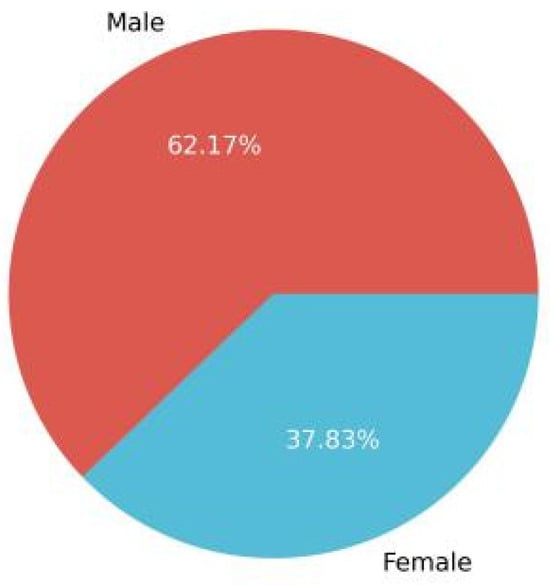
Figure 1.
Drivers’ gender distribution.
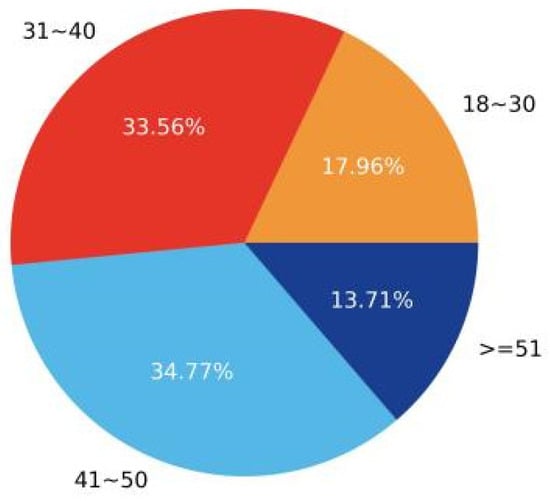
Figure 2.
Drivers’ age distribution.
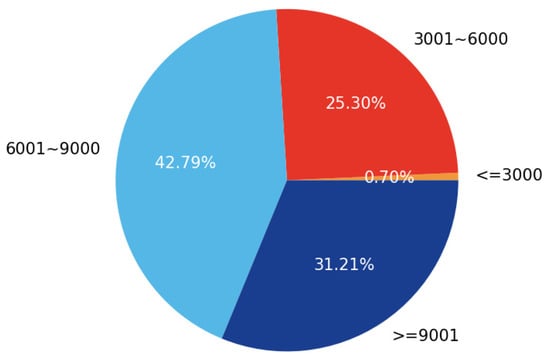
Figure 3.
Drivers’ monthly salary distribution.
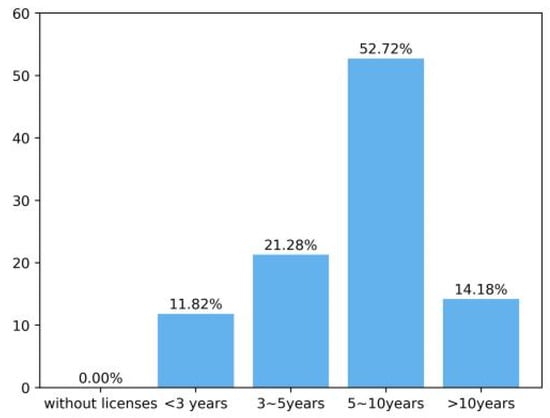
Figure 4.
Drivers’ driving experience distribution.
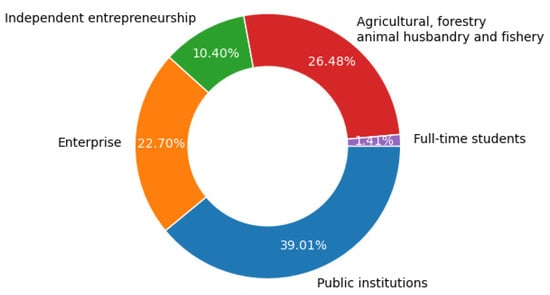
Figure 5.
Drivers’ profession distribution.
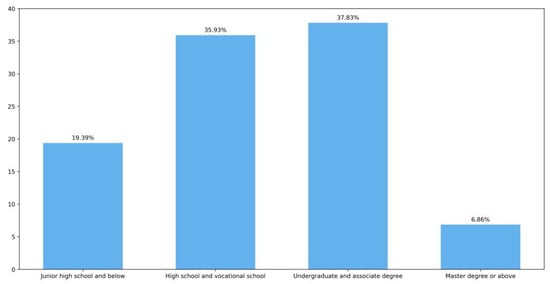
Figure 6.
Drivers’ education experience distribution.
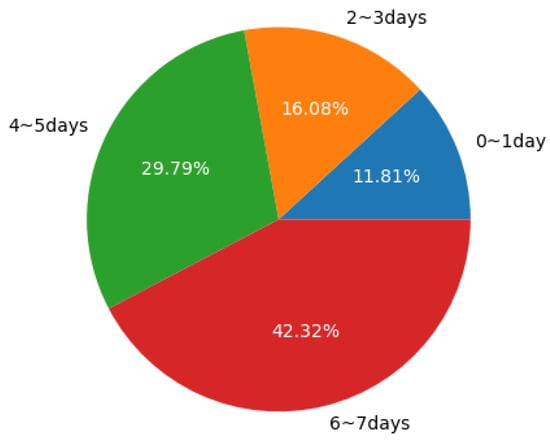
Figure 7.
Drivers’ using vehicles frequency distribution.
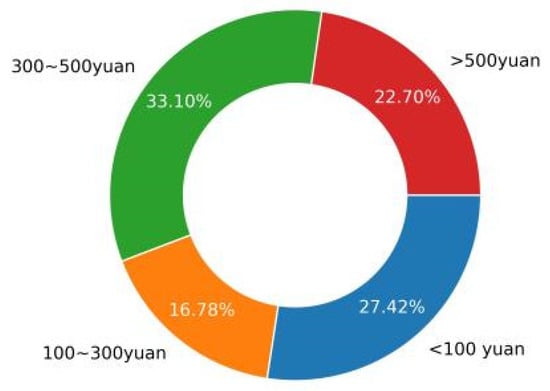
Figure 8.
Drivers’ monthly parking fee distribution.
The results of the questionnaire survey reveal that in Xi’an, male drivers dominate, but female drivers also make up a certain proportion of about 38%. From the perspective of age distribution, drivers are mainly concentrated between the ages of 18 and 50, with the highest number of drivers aged 41 to 50, indicating that middle-aged people are the main group for parking needs. In terms of driving experience, most drivers have less than 10 years of driving experience. In addition, the majority of drivers have a high school education or above, while drivers with a graduate degree or above also make up a certain proportion, close to 7%. This is mainly because Xi’an, as a new first tier city, generally has a higher level of education among its drivers.
3.2. Parking Characteristics Analysis
The personal attribute information of travelers, as the internal driving force of their parking choice behavior, reflects the reasons behind their decisions. The characteristic information of parking lots, as an external manifestation, reveals the patterns of parking choice behavior of travelers in actual environments. These parking lot features include considerations for travelers when parking, travel purposes, parking locations, transportation methods used, typical parking hours, and the availability of public transportation. This detailed parking feature information, their settings, and classifications can be found in Table 2.

Table 2.
Parking feature information setting.
3.2.1. Analysis of Factors Influencing Parking Lot Selection
Parking decision-making is a complex process involving multiple factors, and travelers often need to weigh various factors when making choices. In order to deeply explore the choice behavior of travelers, this survey adopted an importance ranking method, designed multiple choice questions with at least three choices, and ranked them according to their importance. Through this approach, it is possible to gain a more comprehensive understanding of the factors that travelers consider when choosing a parking lot. Based on the survey results, further multiple response analysis was conducted to determine the top three factors that travelers value most when choosing a parking lot. The analysis result is shown in Table 3.

Table 3.
Multiple response analysis of parking choice factors—first ranking.
According to Table 3, the multiple response analysis of first ranking parking lot selection factors shows that among the primary factors that travelers consider when choosing a parking lot, parking price ranks first, accounting for about half, followed by parking time, accounting for 22.5% of cases, and parking time, accounting for 10.4%.
Table 4 shows that about 25% of travelers consider the time point of parking as the second factor when choosing a parking lot, and the number of available parking spaces also accounts for a large proportion of the second factor, at around 20%. The time required to find a parking space accounts for 19.9%.

Table 4.
Multiple response analysis of parking choice factors—second ranking.
The third ranking factor to consider when choosing a parking lot is the length of parking time (shown in Table 5), which is approximately 21.5%; next are the available parking spaces and the distance to the destination, which are 21.3% and 18.2%, respectively.

Table 5.
Multiple response analysis of parking choice factors—third ranking.
The analysis of the factors influencing the choice of parking lots for travelers in the previous text is mainly based on a simple qualitative description of statistical data. In order to further analyze the selection differences among various influencing factors, this article adopts the assignment scoring method to more accurately evaluate the results of the sorting analysis. The steps of calculation are as follows:
Step 1: Ranking of importance of selection factors
Travelers have screened out all factors that affect parking lot selection decisions based on their subjective perceptions and ranked them in order of their importance. Among them, number 1 represents the first important influencing factor, number 2 represents the second important influencing factor, and so on. When designing the questionnaire, travelers are required to select at least three items and sort them. However, the statistical results show that the number of choices exceeding three is relatively small. In order to eliminate the potential interference caused by differences in the number of choices, this article has decided to only conduct a ranking analysis on the first three items.
Step 2: Descending assignment
Assign values to the first three factors in descending order. The first influencing factor is assigned a value of 3, the second influencing factor is assigned a value of 2, the third influencing factor is assigned a value of 1, and all other choices are assigned a value of 0.
Step 3: Final scoring
In order to analyze the importance of each influencing factor more deeply, the total score of each factor and the total number of drivers who chose that factor were calculated, and the results were sorted in a descending order of scores. In the analysis process, the list comparison method was used to present the differences between various factors more intuitively.
It should be noted that since the sorting of multiple questions during the questionnaire input is performed in the form of strings, it is necessary to convert these data variables before conducting analysis. At the same time, it is necessary to convert the sorting order into corresponding numerical values to ensure the accuracy and reliability of the analysis.
Taking parking fees as an example, a total of 196 people considered parking prices as the primary factor, while five and seven people listed them as the second and third factors, respectively. However, 215 people did not choose parking prices as their consideration factor or placed them in a lower position. Based on these data, the total assigned score for parking prices can be calculated. Table 6 shows a summary of the descending assigned values for the factors considered in parking selection. Based on the ranking results of the respondents, drivers generally believe that parking price, parking time, and parking time are the most critical factors, ranking among the top three factors considered. In contrast, the impact of weather conditions and parking lot types is slightly weaker.

Table 6.
Descending assignment of parking selection factors.
Based on the total score of each selection factor listed in Table 7 and the total number of people of 423, the statistics clearly identify the differences in the importance of each influencing factor in driver parking lot selection. Among them, parking price is the most important influencing factor for drivers, with a total of 208 people choosing it. The total score after descending assignment reached 605 points, with an average score of 1.43 points. Following closely behind was the time to find a parking spot, with a total of 184 people choosing this factor, with an average score of 1.08 points. The third influencing factor is the parking time point, with an average score of 0.92 points after descending assignment. These data intuitively demonstrate the degree to which drivers attach importance to different factors in the parking lot selection process; the average score of each selection factor can be further calculated.

Table 7.
Ranking of factors for parking lot selection.
3.2.2. Analysis of the Longest Tolerable Time for Finding a Parking Spot Under Different Travel Purposes
From the distribution Figure 9, it is evident that when the purpose of travel is entertainment and dining, drivers spend most of their time searching for parking spaces within 5 min. However, for commuting purposes such as going to work, going home, and picking up and dropping off children, the time spent searching for a parking spot is relatively long, mainly concentrated within the range of 5 to 10 min.
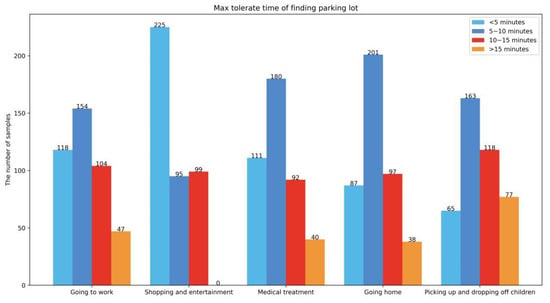
Figure 9.
Time distribution of searching for parking space for different travel purposes.
3.2.3. Analysis of Parking Time Under Different Travel Purposes
According to Figure 10, the distribution of parking time for drivers with different travel purposes can be observed. It can be clearly seen that the parking time for commuting (such as work and home) is relatively similar, with most parking times exceeding 4 h. For non commuting purposes such as shopping, dining, entertainment, and medical treatment, the parking time is mainly concentrated between 4 and 8 h. In addition, the parking time for picking up and dropping off children for travel is relatively short, mainly concentrated in the range of 0 to 2 h.

Figure 10.
Time distribution of parking for different travel purposes.
3.2.4. Analysis of the Maximum Parking Fee That Can Be Tolerated Under Different Travel Purposes
Figure 11 shows the distribution of maximum parking rates that drivers can tolerate. From the graph, it can be seen that the maximum parking rate that drivers can tolerate for travel purposes such as going to work, going home, and picking up and dropping off children is mainly concentrated in the option of 3 yuan/hour. For drivers who travel for shopping, dining, entertainment, and medical purposes, their maximum parking rates are more concentrated in the range of 5–10 yuan/hour.

Figure 11.
Distribution of maximum tolerant parking fee under different travel purposes.
3.2.5. Analysis of the Longest Walking Time That Can Be Tolerated Under Different Travel Purposes
The distribution of the longest walking time that drivers can tolerate is shown in Figure 12. From Figure 12, we can observe that under various travel purposes, the median of the longest walking time that drivers can tolerate is in the second level, which is within the range of 5 to 10 min.
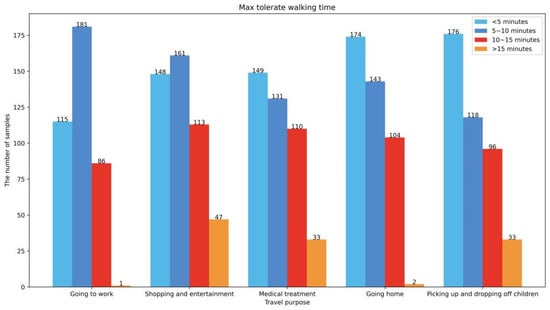
Figure 12.
Distribution of maximum walking time that drivers can tolerate under different travel purposes.
4. Analysis on On-Street Parking Selection Behavior
4.1. Analysis Method
In order to analyze the influencing factors of on-road parking choice behavior of travelers with different travel purposes and provide theoretical support for regulating on-road parking demand, this section examines on-road parking choice behavior and models and analyzes their choice behavior through a binomial logit model using the data from the questionnaire survey and the spatio-temporal characteristics of on-road parking, combined with the parking feature data of the respondents.
4.1.1. Logistic Model
Logistic regression [18], also known as logistic regression analysis, is a generalized linear regression analysis model, and its general expression is as follows:
According to Equations (2) and (3), we have Equations (4) and (5).
where Equation (5) is the logarithmic form of Equation (4).
4.1.2. Binomial Logistic Model
The Binomial Logistic (BL) model is the most common discrete choice model, commonly used to analyze and predict the process of decision-makers selecting one option from two choices [19].
We let . p represent the probability of Y = 1, also represented as here. m means that there are m independent variables in this model. The corresponding BL regression model is shown in Equation (6):
where is the intercept and is the partial regression coefficient of when .
Let , we have Equation (7):
The above equation is the logarithmic form of the Logistic function, i.e., the logit function, where is called the occurrence ratio of events (odds), also known as the ratio of the probability of an event occurring to not occurring.
4.1.3. Parameter Estimation of Binomial Logistic Model
Assuming y is a binary variable, are variables related to y that can be accurately measured. Corresponding observation values are ; thus, the corresponding logit model is shown as Equation (8):
The probability function of is Equation (9):
We can obtain the likelihood function of , Equation (10):
Therefore, its natural logarithmic log function is Equations (11) and (12):
Therefore, we can obtain , the maximum likelihood estimate of , through iterative calculation.
4.1.4. Regression Coefficient of Binomial Logistic Model
The coefficients of the variables included in the logistic model should be significant; therefore, significance testing [20] should be conducted on the regression coefficients included in the model before analyzing the results.
The original hypothesis and alternative hypothesis for testing the significance of regression coefficients of variables are shown in Equation (13):
Use the following statistical measures to test the significance of regression coefficients, as shown in Equation (14):
If , and the probability of the original hypothesis is less than the predetermined level of significance, we reject the original hypothesis and assume that the regression coefficient of the variable is not entirely zero. Accept the alternative hypothesis and assume that the regression coefficient of the variable plays a role in predicting changes in the dependent variable.
4.1.5. Significance Test of Binomial Logistic Model
In the goodness-of-fit test of a model, which is the significance test of the model, a classification table is usually used to characterize the fitting effect, as shown in the following Table 8:

Table 8.
Classification table.
The boundary value is p = 0.500.
Where , the number of samples with real observation value is , while that of prediction value is . The calculations of ,, and are shown as Equations (15)–(17):
We can also obtain the statistical measure of the goodness of fit by the following Equation (18):
Among them, n is the total number of samples, is the weight of the sample, and is the observation value for sample of the binary dependent variable. is the logistic regression prediction probability for the sample.
Additionally, we applied another three significant test methods: Hosmer–Lemeshow goodness-of-fit, Cox & Snell goodness-of-fit, and Nagelkerke goodness-of-fit to test our proposed model.
1. Hosmer–Lemeshow test
Hosmer–Lemeshow test [21] groups all observation units based on the predicted probability of the model and then calculates the Pearson chi-square based on the measured and expected values of each dependent variable. The goodness-of-fit statistic calculation is shown in Equations (19) and (20):
In the formula, g is the number of groups, represents the actual observation frequency of the group event (Y = 1). represents the expected frequency of the group event (Y = 1), and represents the average probability of the group event (Y = 1) occurring.
The original assumption of the model is that H0 is the same as the observation and expectation; if , we refuse the null hypothesis, which assumes that the observed values of the model are different from the expected values, indicating poor fitting performance.
2. Cox & Snell [22]
The calculation of goodness of fit is shown as Equation (21):
In the formula, is the likelihood ratio of the initial model, which is the likelihood ratio when the model only contains a constant term. is the likelihood ratio of the current model. N is the size of samples. denotes the obtained goodness of fit.
3. Nagelkerke
The value of Cox & Snell cannot be equal to 1, because . Thus, we use Nagelkerke to modify goodness of fit obtained by Cox & Snell , and we obtained Nagelkerke [23].
In this work, we use to denote Nagelkerke . The calculation of is shown as Equation (22):
where , this statistic represents the proportion of the dependent variable’s variance that is explained by the regression equation.
4.1.6. Virtual Independent Variable
In regression analysis, the independent variables are usually numerical variables, which have a linear explanatory effect on the dependent variable. However, in logistic regression, the independent variables are mostly categorical variables, including nominal and ordered variables, which cannot be directly used as explanatory variables in the regression equation. They need to be first transformed into dummy variables.
The main purpose of using categorical variables in regression analysis is to study the differences in the impact of each categorical variable on the dependent variable. By using a binary variable of 0/1, each categorical variable is recorded, with 1 indicating belonging to the same category and 0 indicating not belonging to the same category. For categorical variables of category N, once the reference category is determined, only N − 1 dummy variables need to be set. The coefficient in the obtained logistic regression equation represents the difference in the average contribution of each category to the dependent variable relative to the reference category.
4.2. Model Parameters
The research on parking choice behavior in this article is based on the survey plan design and data in Section 2. The influencing factors of parking choice behavior are divided into three categories: personal socio-economic attributes, parking characteristics, and factors affecting parking behavior under sharing modes. The detailed definitions and expressions are shown in Table 9, Table 10 and Table 11 below.

Table 9.
User attribute factor.

Table 10.
Factors Affecting Parking Conditions.

Table 11.
Parking characteristic factors.
4.3. Independent Variable Factor Analysis
The research on parking choice behavior has a large number of independent variables. In order to avoid the errors caused by the linear relationship between the independent variables in the Logit selection model, factor analysis of the independent variables is first necessary.
Factor analysis is a multivariate statistical analysis method that starts with studying the internal dependencies of variables and then categorizing the variables with complex relationships into a few comprehensive factors.
The KMO test and Bartlett test results for a total of 16 variables, including user attributes, parking characteristics, and parking status, of the respondents are shown in Table 12. The KMO measure of the independent variable is 0.904, which is greater than 0.5, and the significance of Bartlett’s sphericity test is less than 0.05, rejecting the null hypothesis that the correlation matrix is not the identity matrix. Therefore, this group of variables is suitable for factor analysis.

Table 12.
KMO and Bartlett test analysis.
Table 13 shows the process of extracting common factors, indicating the contribution of each variable to the common factors. Extracting common factor variance refers to the estimated variance of each variable explained by the factor in the factor solution. A smaller value indicates that the variable is not suitable as a factor and can be filtered out in the analysis. It can be seen that six variables have a contribution rate of over 70%, while the proportion of other common factors extracted is less than 70%, indicating that they cannot explain other variables well.

Table 13.
Common factor variance.
In order to better analyze the contributions of variables to the result, we arranged the calculated principal component contribution in descending order and numbered variables sequentially from 1 to 16. The principal component results are shown in Table 14, which lists all principal components and ranks them according to the size of their eigenvalues. According to the table, the eigenvalues of the first principal component are 5.137, with a variance contribution rate of 32.107%. There is a total of five components with eigenvalues greater than 1, and the cumulative variance contribution rate of the first five factors is 60.981%, indicating that the first five factors cannot explain the remaining variables well.

Table 14.
Total variance analysis table.
Although factor analysis is useful for understanding the underlying structure of the data, as noted by a reviewer, it is not a direct tool for diagnosing multicollinearity in regression models. To ensure the reliability of the subsequent binomial logit models, we calculated the Variance Inflation Factor (VIF) for all independent variables to formally assess multicollinearity. The VIF measures how much the variance of an estimated regression coefficient is increased due to collinearity with other predictors. A common rule of thumb is that a VIF value above 10 indicates severe multicollinearity [24].
We performed VIF diagnostics on all continuous variables and categorical variables (after being converted into dummy variables). The results (shown in Table 15) indicated that all VIF values were well below the threshold of 10, with the maximum VIF being 3.69. This clearly demonstrates that no severe multicollinearity exists among the independent variables selected for our final logit models, and that the model estimates are stable and reliable.

Table 15.
Variance Inflation Factor.
4.4. Analysis on Logit Model
According to the descriptive analysis in Section 2, it can be concluded that there are significant differences in the parking characteristics of the respondents with different travel purposes. Based on this, this section establishes a parking choice behavior model under differentiated on-road parking fee models for different travel purposes.
4.4.1. Model Relevant Parameter Examine
According to the analysis results in Section 2, it can be seen that there are significant differences in the parking choice characteristics of travelers with different travel purposes. Therefore, correlation tests should be conducted on the parameter variables under different travel purposes to determine the significant correlation variables of on-road parking choice behavior under different travel purposes. The corresponding Table 16 for travel purposes is shown below.

Table 16.
The sample size of different purposes.
Taking shopping, dining, and entertainment as an example, Spearman analysis was conducted using SPSS 26.0 software to examine the significant correlation variables and their coefficients of parking choice behavior under the purpose of shopping, dining, and entertainment travel. The results are shown in Table 17.

Table 17.
Different variables’ correlation coefficient and significance.
According to the rank correlation test results in the table above, when α = 0.01, significant variables related to whether to choose on-road parking spaces for shopping, dining, and entertainment purposes include age, monthly income, occupation, education level, weekly driving days, monthly parking fee, daily parking time, and satisfaction with existing charging policies.
Among them, age, occupation, and weekly driving days are positively correlated, that is, the larger the independent variable value, the easier it is to choose on-road parking spaces; the larger the value for monthly salary, education level, monthly parking fees, daily parking hours, and satisfaction with existing charging policies, the less likely it is to choose on-road parking spaces. For example, the higher the monthly parking fee, the less likely it is to choose on-road parking spaces.
Similarly, the coefficients and significant variables of the rank correlation coefficient test for other travel purposes can be obtained, as Table 18.

Table 18.
Spearman rank correlation coefficient test for significant variables under different travel purposes.
4.4.2. Construction of Binomial Logit Model and Result Analysis
Taking the purpose of shopping, dining, entertainment, and travel as an example, as shown in Table 19, a total of 85 samples participated in the analysis by conducting binary logistic regression analysis on eight independent variables, and there was no missing data.

Table 19.
Basic summary of binary logit regression analysis.
Firstly, an analysis of the overall effectiveness of the model is conducted. From the table above, it can be seen that the null hypothesis for model testing here is whether to include independent variables (Age, Salary, Job, Education, Frequency, Parking fee, Parking time, Satisfaction). The model quality is the same for Salary, Job, Education, Frequency, Parking fee, Parking time, and Satisfaction. As shown in Table 20 (results of the likelihood ratio test for binary logit regression model), the p value is less than 0.05; therefore, the null hypothesis is rejected. The independent variables of the model are valid, and the construction of this model is meaningful.

Table 20.
Likelihood ratio test of binary logit regression model.
Table 21 presents the results of logit regression analysis. According to the statistics given in Table 21, we can obtain on-street parking selection behavior model, shown as Equation (23):

Table 21.
Summary of binary logit regression analysis results.
Taking the monthly parking fee variable as an example to explain the significance of the model, the higher the average monthly parking fee, the easier it is for travelers to accept roadside parking spaces. Similarly, the logit model for parking choice behavior under differentiated pricing of roadside parking spaces for other purposes of travel can be obtained, as shown in Table 22, Table 23, Table 24 and Table 25:

Table 22.
Logit model parameters of going to work.

Table 23.
Logit model parameters of going for medical.

Table 24.
Logit model parameters of going home.

Table 25.
Logit model parameters of picking up and dropping off children.
Where p denotes the probability that Y equals 1, and 1 − p denotes the probability that Y equals 0. When p is below 0.5, travelers ultimately choose an on-street position for parking; otherwise, travelers do not tend to park on the street.
From the model results, it can be seen that
1, The higher the monthly income, the more likely it is to choose roadside parking;
2, The higher the level of education, the more inclined one is to choose roadside parking spaces;
3, The higher the monthly parking fee, the more likely it is to choose roadside parking spaces;
4, The longer the parking time, the easier it is to choose a roadside parking spot.
The accuracy of the model prediction is shown in Table 26 below:

Table 26.
Prediction accuracy under different travel purposes.
From the above Table 26, it can be seen that the accuracy of the model prediction is relatively low under the purpose of going to work and going home. The reason is that the purpose of going to work and going home is for commuting, which belongs to rigid travel purposes. The impact of parking space attributes on parking choices is relatively small, while under the purpose of dining, shopping, entertainment, medical treatment, and picking up and dropping off children, the impact of parking space attributes on parking choices is relatively large. Therefore, the accuracy of the model prediction is relatively high.
5. Conclusions
This study processed and analyzed questionnaire data to determine the variables that can be included in the parking choice behavior model. At the same time, hypothesis tests were conducted on the influencing factors of on-street parking choice behavior under different travel purposes, and significant influencing factors of on-road parking choice behavior corresponding to each travel purpose were determined.
This study established a binomial logit model based on the questionnaire survey data for on-street parking choice behavior of travelers under various travel purposes, and analyzed the factors and influencing mechanisms that affect on-street parking choice under each travel purpose.
This study has made an attempt to investigate the influencing factors of on-street parking choices and how these factors influence those choices. However, the study still has some limitation: (a) the sample is only from Xi’an, which may limit the generalizability of the conclusion to other cities; (b) possible deviations between hypothetical scenarios and actual decisions in SP surveys; (c) potential important factors were not included in the model, such as real-time traffic conditions and the attractiveness of specific destinations; and (d) using p = 0.5 as the default classification threshold may not be the optimal solution. Future work should consider conducting comparative research on multiple cities, validating SP results using GPS data, and exploring machine learning models.
In addition, according to the statistics of the questionnaire and regression, we can observe that parking price influences people’s on-street parking selection. Currently, there are some on-street parking pricing strategies put into use such as SFpark in San Fransisco [25]. A proper on-street parking pricing strategy is also worth researching in Xi’an. Further research can pay more attention to dynamic [26,27] and differentiated pricing [28,29] for on-street parking strategies.
Author Contributions
Conceptualization, Z.W.; methodology, Y.L. and Z.W.; software, W.J. and X.L.; validation, Y.R.; writing—original draft preparation, W.J., X.L., and Y.R.; writing—review and editing, Z.W. and Y.L. All authors have read and agreed to the published version of the manuscript.
Funding
This research was funded by the National Science and Technology Major Project of China under Grant number 2022ZD0115600; the National Natural Science Foundation of China, Grant 52172330 and Grant 52002281; and Hunan Provincial Natural Science Foundation of China under Grant 2023JJ40731.
Institutional Review Board Statement
The study was conducted according to the guidelines of the Declaration of Helsinki. Ethical review and approval were waived for this study due to the use of anonymous survey data with minimal risk.
Informed Consent Statement
Informed consent was obtained from all subjects involved in the study. Participation was voluntary, and respondents were informed about the study’s purpose and the anonymity of their responses.
Data Availability Statement
Some or all data, models, or code generated or used during the study are available from the corresponding author by request. This data is in the form of some Excel files.
Conflicts of Interest
The authors declare no conflicts of interest.
References
- Ministry of Public Security, Traffic Management Bureau. In the First Half of 2025, the Number of Motor Vehicles Nationwide Reached 460 Million, and the Number of Drivers Reached 550 Million. China Government Website. 14 July 2025. Available online: https://www.gov.cn/lianbo/bumen/202507/content_7031802.htm (accessed on 10 September 2025).
- Jakob, M. Parking Policies and Their Impacts on Urban Networks. Ph.D. Thesis, ETH Zurich, Zurich, Switzerland, 2021. [Google Scholar]
- Arnott, R. Spatial competition between parking garages and downtown parking policy. Transp. Policy 2006, 13, 458–469. [Google Scholar] [CrossRef]
- Lehner, S.; Peer, S. The price elasticity of parking: A meta-analysis. Transp. Res. Part A Policy Pract. 2019, 121, 177–191. [Google Scholar] [CrossRef]
- Inci, E. A review of the economics of parking. Econ. Transp. 2015, 4, 50–63. [Google Scholar] [CrossRef]
- Simićević, J.; Vukanović, S.; Milosavljević, N. The effect of parking charges and time limit to car usage and parking behaviour. Transp. Policy 2013, 30, 125–131. [Google Scholar] [CrossRef]
- Wang, H.; Li, R.; Wang, X.C.; Shang, P. Effect of on-street parking pricing policies on parking characteristics: A case study of Nanning. Transp. Res. Part A Policy Pract. 2020, 137, 65–78. [Google Scholar] [CrossRef]
- Albert, G.; Mahalel, D. Congestion tolls and parking fees: A comparison of the potential effect on travel behavior. Transp. Policy 2006, 13, 496–502. [Google Scholar] [CrossRef]
- Tian, Q. The optimal searching strategies of curbside parking with schedule delay penalties. Transp. A Transp. Sci. 2016, 12, 533–549. [Google Scholar] [CrossRef]
- Hensher, D.A.K. Parking demand and responsiveness to supply, pricing and location in the Sydney central business district. Transp. Res. Part A 2001, 35, 177–196. [Google Scholar] [CrossRef]
- Guo, Z. Home parking convenience, household car usage, and implications to residential parking policies. Transp. Policy 2013, 29, 97–106. [Google Scholar] [CrossRef]
- Qian, Z.S.; Xiao, F.E.; Zhang, H.M. Managing morning commute traffic with parking. Transp. Res. Part B 2012, 46, 894–916. [Google Scholar] [CrossRef]
- Hess, S.; Bierlaire, M.; Polak, J.W. Estimation of value of travel-time savings using mixed logit models. Transp. Res. Part A Policy Pract. 2005, 39, 221–236. [Google Scholar] [CrossRef]
- Parmar, J.; Das, P.; Dave, S.M. Study on demand and characteristics of parking system in urban areas: A review. J. Traffic Transp. Eng. 2020, 7, 111–124. [Google Scholar] [CrossRef]
- Shoup, D.C. Cruising for parking. Transp. Policy 2006, 13, 479–486. [Google Scholar] [CrossRef]
- Fosgerau, M.; De Palma, A. The dynamics of urban traffic congestion and the price of parking. J. Public Econ. 2013, 105, 106–115. [Google Scholar] [CrossRef]
- Qin, H.; Zheng, F.; Yu, B.; Wang, Z. Analysis of the effect of demand-driven dynamic parking pricing on on-street parking demand. IEEE Access 2022, 10, 70092–70103. [Google Scholar] [CrossRef]
- Nick, T.G.; Campbell, K.M. Logistic regression. In Topics in Biostatistics; Humana Press: Totowa, NJ, USA, 2007; pp. 273–301. [Google Scholar]
- Grøn, R.; Gerds, T.A. Binomial regression models. In Handbook of Survival Analysis; Chapman and Hall/CRC: Boca Raton, FL, USA, 2014; p. 221. [Google Scholar]
- Blizzard, L.; Hosmer, W. Parameter estimation and goodness-of-fit in log binomial regression. Biom. J. 2006, 48, 5–22. [Google Scholar] [CrossRef]
- Kramer, A.A.; Zimmerman, J.E. Assessing the calibration of mortality benchmarks in critical care: The Hosmer-Lemeshow test revisited. Crit. Care Med. 2007, 35, 2052–2056. [Google Scholar] [CrossRef] [PubMed]
- Cockeran, M.; Meintanis, S.G.; Allison, J.S. Goodness-of-fit tests in the Cox proportional hazards model. Commun. Stat.-Simul. Comput. 2021, 50, 4132–4143. [Google Scholar] [CrossRef]
- Nagelkerke, E.; Oberski, D.L.; Vermunt, J.K. Goodness-of-fit of multilevel latent class models for categorical data. Sociol. Methodol. 2016, 46, 252–282. [Google Scholar] [CrossRef]
- Hastie, T.; Tibshirani, R.; Friedman, J. An Introduction to Statistical Learning; Springer: Berlin/Heidelberg, Germany, 2009. [Google Scholar]
- Fabusuyi, T.; Hampshire, R.C. Rethinking performance based parking pricing: A case study of SFpark. Transp. Res. Part A Policy Pract. 2018, 115, 90–101. [Google Scholar] [CrossRef]
- Saharan, S.; Kumar, N.; Bawa, S. DyPARK: A dynamic pricing and allocation scheme for smart on-street parking system. IEEE Trans. Intell. Transp. Syst. 2023, 24, 4217–4234. [Google Scholar] [CrossRef]
- Zheng, N.; Geroliminis, N. Modeling and optimization of multimodal urban networks with limited parking and dynamic pricing. Transp. Res. Part B Methodol. 2016, 83, 36–58. [Google Scholar] [CrossRef]
- Piccioni, C.; Valtorta, M.; Musso, A. Investigating effectiveness of on-street parking pricing schemes in urban areas: An empirical study in Rome. Transp. Policy 2019, 80, 136–147. [Google Scholar] [CrossRef]
- Zhou, X.; Lv, M.; Ji, Y.; Zhang, S.; Liu, Y. Pricing curb parking: Differentiated parking fees or cash rewards? Transp. Policy 2023, 142, 46–58. [Google Scholar] [CrossRef]
Disclaimer/Publisher’s Note: The statements, opinions and data contained in all publications are solely those of the individual author(s) and contributor(s) and not of MDPI and/or the editor(s). MDPI and/or the editor(s) disclaim responsibility for any injury to people or property resulting from any ideas, methods, instructions or products referred to in the content. |
© 2025 by the authors. Licensee MDPI, Basel, Switzerland. This article is an open access article distributed under the terms and conditions of the Creative Commons Attribution (CC BY) license (https://creativecommons.org/licenses/by/4.0/).